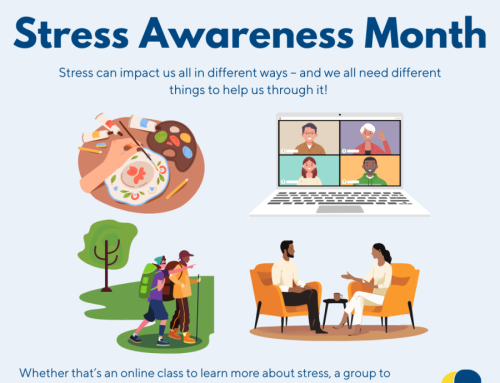For Stammering Awareness Day, Katie, our Volunteering and Peer Support Coordinator, has shared a blog on her experiences of stammering and top tips for supporting someone with a stammer.
My name is Katie and I have had a stammer ever since I started to speak at 4 years old. International Stammering Awareness Day (ISAD) is 22nd October.
For me it’s important to talk about stammering because although it doesn’t define me, it’s a huge part of who I am and it’s something I’m learning to be proud of. As an invisible impediment, it is sometimes misunderstood by ‘fluent speakers’ – it has often been the butt of jokes in old TV shows and comedians’ sets and undermined by statements like “Ah, I stutter when I’m nervous!” or “I can’t speak properly today!”. Although these kinds of flippant statements aren’t meant to cause upset, they can make a person feel like they’re making a ‘big deal’ out of something which they have to think about all the time, every time they want to speak.
Because stammering has very little visibility, people’s reaction when they hear a stammer can take many inappropriate forms, and people often misunderstand why someone appears to stumble when they talk, assuming it’s nerves or that the person is drunk or unwell. Because of these encounters, I try to tell people as soon as possible, ‘I have a stammer, please bear with me’. However, this isn’t always easy, and it shouldn’t always be our job to educate.
Opening your mouth and saying anything you want to say is something fluent speakers take for granted. People who stammer don’t have this luxury. For many it’s constantly on their mind, anticipating when they’ll need to speak, making and receiving calls and trying to keep up with conversation. For some, the fear of stammering is so high they avoid and swap words they struggle on, may stay silent or appear ‘shy’ to others. They want to appear fluent so will do everything they can to hide the fact that they stammer.
What is stammering?
Stammering is a neurological condition that makes it physically hard to speak. It affects 1 in 100 people. You may hear the terms stammering or stuttering – this is the same thing, it just comes down to preference.
Stammers can vary between person to person and can be described as a spectrum – everyone stammers differently and to different degrees. Someone who stammers may repeat, prolong a word/sound and there may be signs of visible freezing, struggle and tension as they struggle to get the word out. People may get ‘stuck’ on sounds or words, which can be described as ‘silent blocks’. As you can imagine, this makes using the telephone challenging… cue “Hello? Helloooo?!” or “I think there’s something wrong with your line, you’re breaking up”. Having a stammer can be extremely frustrating and sometimes even painful, if the struggle is severe you might end up biting the inside of your mouth or tongue, desperately trying to get a sound out as quickly as possible so you don’t lose your audience.
Facts about stammering:
- About 8%* of children will stammer at some point. Most will go on to talk fluently and grow out of it, whereas for up to 3%* of adults it will be a lifelong condition.
- Stammering can affect anybody from any background, although statistics show it affects more men than women.
- We don’t know enough about what causes stammering, but there are many theories.
- There is no link between stammering and intellectual capacity.
- Stammering is not caused by nervousness or confusion – the person knows exactly what they want to say, they simply struggle to say it. There are situations that might exacerbate stammering e.g. stress caused by interviews, introductions etc, or personal circumstances like fatigue or illness, but they don’t cause the stammer itself.
- Some people might categorise their stammers into ‘overt’ and ‘covert’ stammers.
- Overt stammers can appear more outwardly “severe” and noticeable with severe blocks, prolongation or repetition.
- Covert stammers may not be as noticeable. The person may try and hide it, using tricks such as the overuse of filler words e.g. ‘erm’, ‘like’, ‘you know’, or physical tricks like tapping their foot.
- Stammering can vary and people can often appear to be covert and overt at different times. Societal expectations mean that people will often try to avoid stammering as much as they can.
* Stats from What is Stammering? | STAMMA
As the British Stammering Association (now known as STAMMA) says, it’s not all about the stammer itself or what the listener hears it is “feelings of shame, embarrassment, anger, anxiety and fear. Frustration that saying one’s name – the one thing that most people who stammer will find hard to say – will stymie your every encounter. The frustration of not being taken seriously. For many people who stammer it is this aspect of having a stammer which forms the greater part of the experience.”
So, you’re probably thinking, what can I do to help? How can I support a colleague at work, or a service user with a stammer?
Top tips for supporting someone with a stammer:
- Advice. Don’t go there. Don’t tell the person to ‘slow down’, ‘take a breath’, or ‘relax’. And definitely don’t make the joke: ‘Did you forget your name?’
- Please don’t finish their sentences or try and guess what’s coming next, often it’s wrong or even if it’s right it can make people feel undermined or disempowered. Just wait.
- Don’t interrupt or speak over them.
- Maintain natural eye contact, listen, and wait until the person has finished speaking. Don’t be put off if the person can’t give eye contact back, it can be difficult to, but if you’re responding in a positive way, not looking away/uncomfortable that can help.
- Let the speaker know you are listening. Focus on what they’re saying, not how they say it.
- Stammering varies. People who stammer may have most difficulty when starting to speak and less difficulty once underway, some may continuously stammer throughout an interaction.
- People who stammer often find controlling their speech on the phone particularly hard. If you pick up the phone and hear nothing, give the caller plenty of time to speak.
- Don’t be afraid to ask them how you can make it easier for them – we’re all different.
- When someone stammers, you might assume they’re unsure of what they’re saying. They aren’t. They may be checking their speech and considering how to say something. They may also talk very fast. If you miss something, ask them to repeat it.
- People who stammer usually find saying their name particularly hard. Please don’t ever ask ‘have you forgotten your name?’ As a manager or colleague, prior to a meeting with new people, it may be helpful to ask the person who stammers privately if they would like to introduce themselves or if they’d like you to introduce them. Or if there is anything else that would help.
- If you are in a group of people nattering away, make sure you can see the person who stammers. If you see that they want to speak, interrupt the flow and invite them to share their thoughts. Set an example to others.
- As a manager, the person may need to take time to access speech therapy or speech courses to work on their speech. Allow for this and make adjustments for the person if needed.
Further reading & resources
- Welcome to Stamma | STAMMA (formerly The British Stammering Association) Lots of resources, leaflets, support and advice.
- Employers & HR Professionals | STAMMA – Resources and advice for employers/colleagues
- Michael Palin Centre for Stammering – The Michael Palin Centre for Stammering – Advice for parents and professionals, support services
- Stammering – NHS (www.nhs.uk) – information and advice
- McGuire Programme – Beyond Stuttering – YouTube – videos from people who stammer, information about courses/support
- Find The Right Words | Stamma on Vimeo – Stamma campaign
- How The Pandemic Affected People with a Stammer – How the pandemic has affected people who stammer/stutter
- Things Not to Say to Someone Who Stammers – Video – Things not to say to someone who stammers
- Its How We Talk Campaign – Stamma





